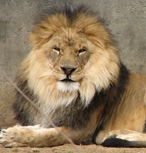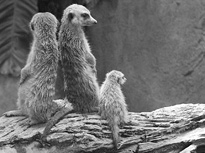Carnivora -- Fiery Predators, have claws, will kill!



Origins
The name of the order is derived from two latin words "caro" (flesh) and "vora" (devour). Sounds dangerous, eh? Well they are dangerous in the sense that they subsist on mostly meat as a cornerstone of their diet. Almost all the time, to obtain this meat they have to kill some poor hapless herbivore or rodent. They are one of the most diverse order of mammals with member ranging from a few grams(Least Weasel) to 5,000 Kg of Elephant Seal bulk.
These mammals probably evolved in North America out of members of the family Miacidae around 42 million years ago. They soon split into cat-like and dog-like forms (Feliformia and Caniformia) and now dominate all the land form as the top predator species within them.
What are they like?
They have teeth that are designed like various kitchen knives all to cut meat. Their special adaptation is the carnassial teeth that are blade-like and designed to shear meat in a scissoring action. They usually possess 6 incisors and two canine teeth on each jaw.
The super-family Canoidae(dogs) has non-retractable claws and mostly comprises of predators that run after their prey and are not stealth killers. Their coats are not spectacularly marked as they need to blend into sub-arctic and temperate grassland existence.
The super-family Feloidae(cats) has retractable claws and most comprises of predators that hunt by stealth. The cheetah is a very rare exception. Their coats extremely gaudy and give them much needed camouflage in their mostly tropical existence.
The super-family Pinnipeds(Walrus,Seals and Sea Lions) have evolved to hunt in the oceans and their claws have actually developed webbing and modified themselves into flippers to swim. These creatures also have a lot of blubber beneath their skin to protect against losing too much heat to their surroundings.
The skull structures of carnivores are very much constructed to support their rather large teeth. The characteristic skull shape with relatively large brains is encased in a heavy skull. Their digestive systems are also designed more simply than the herbivores, to absorb meat.
Geographic Distribution
View Larger Map
Reproduction
Carnivores tend to produce a single litter annually,depending on when the food supply is most assured. Some produce multiple litters a year, and larger carnivores like bears have gaps of 2–3 years between litters. The average gestation period lies between 50-115 days, although the ursids and mustelids have delayed implantation. Litter sizes are usually small, ranging from 1-13 young, which are born with underdeveloped eyes and ears. In most species, the mother has exclusive or at least primary care of the offspring. Many species of carnivores are solitary, but a few are gregarious.
Feeding Habits
These animals are mostly meat-eaters. There are exceptions like the Giant Panda that subsist on bamboo alone. Some are omnivorous and will eat all that they can find. Most carnivores are hunters and need to kill other animals with their specialized claws and formidable teeth.
Families within Carnivora
Nandiniidae(African Palm Civet)
Odobenidae(Walrus)
Prinonodontidae(Asiatic linsangs)
Felidae(Cats)
Viverridae(Civets)
Hyaenidae(Hyenas & Aardwolf)
Eupleridae(Fossa)
Herpestidae(Mongooses)
Canidae(Dogs)
Ursidae(Bears)
Ailuridae(Red Panda)
Mephitidae(Skunks)
Mustelidae(Weasels & Badgers)
Procyonidae(Raccoons)
Otariidae(Sea Lions)
Phocidae(True Seals)
Videos
Odobenidae(Walrus)
Prinonodontidae(Asiatic linsangs)
Felidae(Cats)
Viverridae(Civets)
Hyaenidae(Hyenas & Aardwolf)
Eupleridae(Fossa)
Herpestidae(Mongooses)
Canidae(Dogs)
Ursidae(Bears)
Ailuridae(Red Panda)
Mephitidae(Skunks)
Mustelidae(Weasels & Badgers)
Procyonidae(Raccoons)
Otariidae(Sea Lions)
Phocidae(True Seals)
Videos
Prinonodontidae(Asiatic linsangs)
Felidae(Cats)
Viverridae(Civets)
Hyaenidae(Hyenas & Aardwolf)
Eupleridae(Fossa)
Herpestidae(Mongooses)
Canidae(Dogs)
Ursidae(Bears)
Ailuridae(Red Panda)
Mephitidae(Skunks)
Mustelidae(Weasels & Badgers)
Procyonidae(Raccoons)
Otariidae(Sea Lions)
Phocidae(True Seals)
Videos
Felidae(Cats)
Viverridae(Civets)
Hyaenidae(Hyenas & Aardwolf)
Eupleridae(Fossa)
Herpestidae(Mongooses)
Canidae(Dogs)
Ursidae(Bears)
Ailuridae(Red Panda)
Mephitidae(Skunks)
Mustelidae(Weasels & Badgers)
Procyonidae(Raccoons)
Otariidae(Sea Lions)
Phocidae(True Seals)
Videos
Viverridae(Civets)
Hyaenidae(Hyenas & Aardwolf)
Eupleridae(Fossa)
Herpestidae(Mongooses)
Canidae(Dogs)
Ursidae(Bears)
Ailuridae(Red Panda)
Mephitidae(Skunks)
Mustelidae(Weasels & Badgers)
Procyonidae(Raccoons)
Otariidae(Sea Lions)
Phocidae(True Seals)
Videos
Hyaenidae(Hyenas & Aardwolf)
Eupleridae(Fossa)
Herpestidae(Mongooses)
Canidae(Dogs)
Ursidae(Bears)
Ailuridae(Red Panda)
Mephitidae(Skunks)
Mustelidae(Weasels & Badgers)
Procyonidae(Raccoons)
Otariidae(Sea Lions)
Phocidae(True Seals)
Videos
Eupleridae(Fossa)
Herpestidae(Mongooses)
Canidae(Dogs)
Ursidae(Bears)
Ailuridae(Red Panda)
Mephitidae(Skunks)
Mustelidae(Weasels & Badgers)
Procyonidae(Raccoons)
Otariidae(Sea Lions)
Phocidae(True Seals)
Videos
Herpestidae(Mongooses)
Canidae(Dogs)
Ursidae(Bears)
Ailuridae(Red Panda)
Mephitidae(Skunks)
Mustelidae(Weasels & Badgers)
Procyonidae(Raccoons)
Otariidae(Sea Lions)
Phocidae(True Seals)
Videos
Canidae(Dogs)
Ursidae(Bears)
Ailuridae(Red Panda)
Mephitidae(Skunks)
Mustelidae(Weasels & Badgers)
Procyonidae(Raccoons)
Otariidae(Sea Lions)
Phocidae(True Seals)
Videos
Ursidae(Bears)
Ailuridae(Red Panda)
Mephitidae(Skunks)
Mustelidae(Weasels & Badgers)
Procyonidae(Raccoons)
Otariidae(Sea Lions)
Phocidae(True Seals)
Videos
Ailuridae(Red Panda)
Mephitidae(Skunks)
Mustelidae(Weasels & Badgers)
Procyonidae(Raccoons)
Otariidae(Sea Lions)
Phocidae(True Seals)
Videos
Mephitidae(Skunks)
Mustelidae(Weasels & Badgers)
Procyonidae(Raccoons)
Otariidae(Sea Lions)
Phocidae(True Seals)
Videos
Mustelidae(Weasels & Badgers)
Procyonidae(Raccoons)
Otariidae(Sea Lions)
Phocidae(True Seals)
Videos
Procyonidae(Raccoons)
Otariidae(Sea Lions)
Phocidae(True Seals)
Videos
Otariidae(Sea Lions)
Phocidae(True Seals)
Videos
Phocidae(True Seals)
Videos
Videos